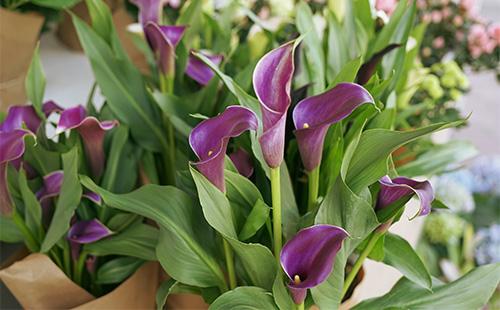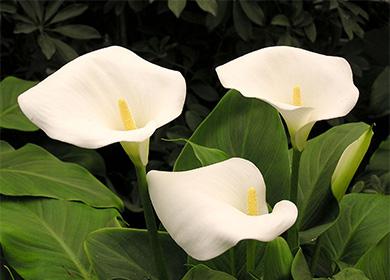The content of the article
Zantedesia is an overseas guest. The natural habitat is South Africa. Belongs to the family of aroid, genus - of the same name. Perennial plant, preferring wet areas - grows mainly in swamps. An interesting feature of the “African beauty” is that in clear weather a distinct pineapple aroma comes from the flowers.
Botanical Description
Tuberous perennial plant. In addition to swamps, it is found on the coasts of warm and humid tropical forests. The rhizome is branched, powerful, completely immersed in water. Strong erect shoots depart from the rhizome. Leaves on tall petioles, large, heart-shaped. The color is often uniformly green, sometimes mixed with white or light shades of cream color.
An inflorescence is an ear of corn wrapped in a veil of various colors. There are varieties with purple, white, red, yellow, creamy bedspreads. Sometimes in color two colors are harmoniously combined. Not a bright contrast, but a smooth transition of tones is characteristic. The inside is usually a little lighter. It blooms for a long time - from spring to autumn.
Popular varieties
The genus is not numerous. According to various sources, it includes from six to eight species of plants. Most of them are found in room culture. In addition to natural forms, breeders have bred hybrid varieties with interesting colors, bright decorative characteristics. Five species are considered the most popular.
- Zantedesia Ethiopian. Grassy perennial with developed rhizome. It features beautiful heart-shaped leaves. Inflorescence — the cob blossoms high above the leaves. The ear is yellow, the cover is white, waxy. The most famous variety of callas.
- Zantedesia is white-spotted. The largest variety with swept oblong foliage. The characteristic coloration is green with white spots. The stems are straight, leaves attached to them with elongated petioles. The bedspread is white or pale yellow, the base is colored in purple.
- Zantedesia Elliot. A short species with elongated heart-shaped leaves. Coloring is green, with strokes of white color. The bedspread is pale yellow on the inside, and a yellowish-green hue on the outside.
- Zantedesia Remanne. Relatively low species - grows no more than 65 cm. The bedspread around the ears is pink, the root system is tuberous.
- Zantedesia mix. Not a standalone variety. It is a mixture of hybrid varieties of different colors.
Caring for the Zantedescu: what to remember the grower
How to care for Zantedesk? Callas can not be called very capricious, but there are still a number of features of care. Experienced flower growers recommend adhering to the following microclimate parameters and care rules.
- Lighting. Feels an increased need for lighting. They put in the brightest place, but protect from direct sun and drafts. In winter, it is advisable to organize artificial lighting. As an analogue of phytolamps, you can use ordinary fluorescent lamps. If in winter the zantedescia did not receive additional illumination, in the spring it is gradually accustomed to light.
- Temperature. Heat-loving culture. Favorable temperature of keeping is not lower than 18 ° С, optimal temperature is 22–23 ° С. In winter, a temperature drop of up to 12 ° C is permissible.
- Watering. In summer and spring, watered with plenty of warm, non-chlorinated water. In winter, the frequency and intensity of irrigation depends on the temperature of the content. At temperatures below 15 ° C, they are watered gently, they do not allow stagnation of liquid, waterlogging of the soil.
- Humidity. One of the main requirements is a high humidity of 85%. Spraying is a mandatory, daily procedure. Periodically, the leaves are gently wiped with a damp cloth from dust. The pot is placed on a wide tray with water. The base of the pot should not come in contact with the liquid - the pan is filled with pebbles or decorative stone.
- Top dressing. You need to feed a calla (zantedescu) for a limited period of time - from about mid-February to June. Fertilizers are applied twice a month. Use tools for flowering plants. For good flowering make compounds containing phosphorus. Weakened plants are fed with nitrogen to gain green mass.
- The soil. The composition of the soil includes turf, well rotated humus, leafy soil, small peat and sand of medium fraction. Recommended proportions are 2: 1: 1: 1: 1. It is advisable to prepare the soil yourself - in universal storey soils, zantedesia grows worse.
- Transfer. Transplanted after the flowering period - in June or July. Before transplanting, watering is minimized, feeding is stopped. The moment of leaf fall is the best time for transplanting. The roots are completely free from old soil, the leaves are pruned. The pot is chosen quite spacious, always with drainage holes at the bottom.
- Pruning. From the second half of July, new lateral shoots actively begin to grow in zantedeskia. They inhibit the subsequent growth and flowering of the plant, so they are cut off immediately.
Breeding methods
The easiest way to propagate tuberous varieties is the separation of children during transplantation and their subsequent rooting in wet sand with the addition of peat. The mother plant itself can be rejuvenated.
For this, the tubers are divided once every two or three years. Division does not weaken the plant, but rejuvenates it, stimulates annual flowering. When dividing, do not use cutting tools - tubers are simply broken by hands. At the same time, they make sure that on each piece there are full kidneys. Places of breakage are necessarily numbed with coal powder, only then they are planted.
For seed propagation, only freshly harvested seeds are used. Over time, they lose their germination. Seeds are sown in early spring in light sandy peat soil, covered with a film. Keep warm in good light. After emergence, the film is removed.The grown seedlings can be planted in separate pots. Supporters of this method of reproduction are not very many. In reviews, flower growers often write that plants from seeds develop slowly, bloom only in the fifth year.

Growing errors and their consequences
Exotic zantedescia is a tropical plant. She immediately responds to improper care by a decrease in decorativeness, lethargy, and yellowing of foliage. There are a number of errors that are most often made by flower growers who first deal with calla lilies. Their description and consequences can be found in the table.
Table - Errors in the care of Zantedesk, their consequences and solutions
| Care Error | What is the reason | How to solve the problem |
|---|---|---|
| Zantedesk not blooming | - Changed the usual place; - did not transplant for a long time; - the bush has not been divided for a long time; - the plant was removed in a dark place; - incorrectly organized the rest period | - Correct the care regimen; - share at the same time as a transplant; - select a well-lit place without drafts |
| Leaves are crumbling | - Did not make top dressing; - removed from the light | - Conduct extraordinary feeding; - rearranged to a brighter place |
| Zantedesia leaves turn yellow | - Maintained low humidity in the room; - allowed overdrying or flooding an earthen coma; - did not notice the appearance of pests; - supercooled rhizomes when irrigated with cold water | - In winter, cleaned from a cold windowsill; - inspect for pests; - increase humidity; - normalize the watering mode |
| Leaves fade and hang | - Allowed the appearance of drafts; - dried the soil | - For zantedesk find a place without drafts; - watered regularly, do not allow complete drying of the soil |
| Leaves and roots rot | - Lowered the temperature in the room; - flooded the flower | - Transplanted zantedeskuyu in new soil; - the number of watering is reduced |
Common diseases
Zantedesia is often affected by fungal diseases. Weakened plants that do not receive proper care are most susceptible to diseases. Signs of diseases, their names and methods of treatment are described in detail in the table.
Table - Diseases of Zantedesia
| The name and cause of the disease | Characteristic symptoms | Treatment methods |
|---|---|---|
| Gray rot (fungus) | - The appearance of a dirty gray coating on the leaves; - staining the bedspreads in green or brown; - withering of the zantedescia | - Pruning of diseased leaves and peduncles; - treatment with fungicides "Fundazol", "Rovral"; - transplantation into sterile soil; - regular airing of the room |
| Anthracnose (fungus) | - The appearance of small, slightly depressed spots; —Increasing the size of spots, the formation of a red edging around them; - drying of leaves, the appearance of cracks on them; | - Removing damaged leaves; - treatment with systemic fungicides |
| Root rot (fungus) | - Withering, drying leaves, peduncles; - rotting of tubers and roots; - plant death | - Transplantation into sterile soil with the removal of damaged areas; - reduction of watering; - processing fungicide "Previkur", "Profit Gold" |
| Bacterial rot (bacteria) | - Darkening of peduncles, petioles, rhizomes; - the appearance of wet rot; - yellowing of leaves | - Cutting out areas of rot, plant transplantation into a dry sterile substrate; - treatment with fungicides (usually it is not possible to save the plant) |
| Yellow spotting (virus) | - Deformation of flowers; - twisting of leaves; - the appearance of light annular spots | - extermination of insects (thripsy virus) |
Frequent pests and methods of controlling them
Pests develop more actively on callas under inappropriate conditions of detention. For example, the spread of a spider mite provokes too dry air.They begin to fight pests right away - at the first sign of infection. A table will help you identify a pest and learn how to deal with it.
Table - Pests of Santedesk
| Pest name | External signs | Ways to fight |
|---|---|---|
| Thrips | - Shedding pollen from flowers; - the appearance of small black dots; - coating of leaves with silver coating | - Repeated treatment of zantedesia with insecticides "Tanrek", "Spark" |
| Spider mite | - The appearance of small bright spots on the leaves; - the formation of in situ dots of vast, colorless, dried patches; - the appearance of a web on the back of the sheet | - Increase in humidity; - treatment of plants with soapy water; - spraying with the drug "Aktara" |
| Aphid | - Twisting and yellowing of new leaves; - the appearance of a sticky, sugar coating | - Cutting deformed leaves; - rubbing the plant with a sponge dipped in soapy water; - spraying with any preparation containing permethrin or tobacco dust infusion |
| Nematodes | - Slowdown of growth; - leaf deformation; - absence or cessation of flowering | - Isolation of zantedescia from healthy plants; - repeated watering of the earth and spraying the plant with an insecticide (in most cases, it is not possible to save the flower) |
| Shield | - The appearance of brown convex plaques; - formation of sticky drops on leaves and petioles; - wilting plants | - Removing shields manually with a soft brush or tweezers; - rubbing all parts of the plant with alcohol; - spraying with any insecticide |
Cultivating zantedesca at home is not as difficult as it might seem at first glance. It is very simple to make friends with the capricious “African beauty” - just create a favorable microclimate and follow the basic rules of care.

